Celebrating 10 years with 10 amazing butterflies of the South Downs National Park
July 9, 2020
“Spending time with butterflies lifts the spirits and reinvigorates that sense of wonder in the natural world.”
Poignant words from Sir David Attenborough, who, like so many of us, is enthralled by the sight of butterflies dancing from blossom to blossom in a wildflower meadow.
Spring and summer in the South Downs is synonymous with these fascinatingly diverse and colourful insects. Their incredible diversity is thanks to the chalk grassland – a truly unique habitat – that supports a huge medley of nectar-rich flowers. Combine the floristic diversity and all its many hues with these colourful creatures and you have any wildlife photographer’s dream!
In fact, over 30 different species of butterfly can be on the wing at any given time above the South Downs National Park’s chalk grasslands. The grasslands are just one of the habitats supporting butterflies as heathland and woodland also support a multitude of species and did we mention the South Downs is also a stronghold for the butterfly’s close cousin, the majestic moths!
As we prepare for Virtual Wild Chalk – a six-day celebration of our wonderful chalk grassland from 19 July – we asked our Ranger team to name their favourite butterflies from the National Park’s grasslands.
And, as it’s the 10th birthday of the South Downs National Park this year, here are 10 of their personal favourites!
Duke of Burgundy
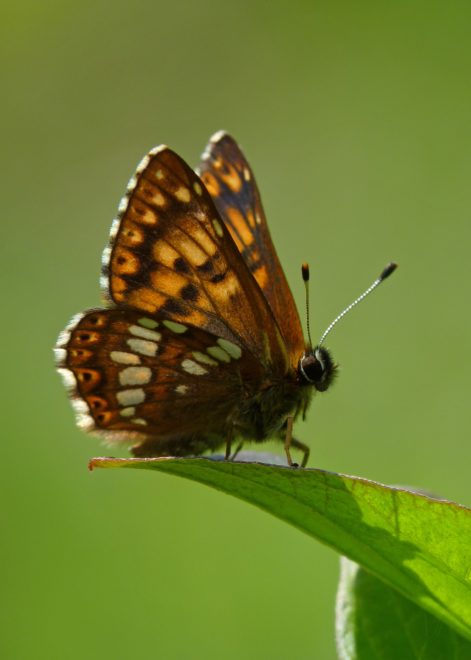 Small and orange and brown, the Duke of Burgundy is found only in central and southern England and more isolated colonies in the southern Lake District and the North York Moors. Its recovery in the South Downs has been a major conservation success for the National Park.
Small and orange and brown, the Duke of Burgundy is found only in central and southern England and more isolated colonies in the southern Lake District and the North York Moors. Its recovery in the South Downs has been a major conservation success for the National Park.
A favourite of Ranger Simon Mockford, he says: “It’s a stunning butterfly with attitude and will chase off any other species including dragonflies which dare enter its territory!”
Small Copper
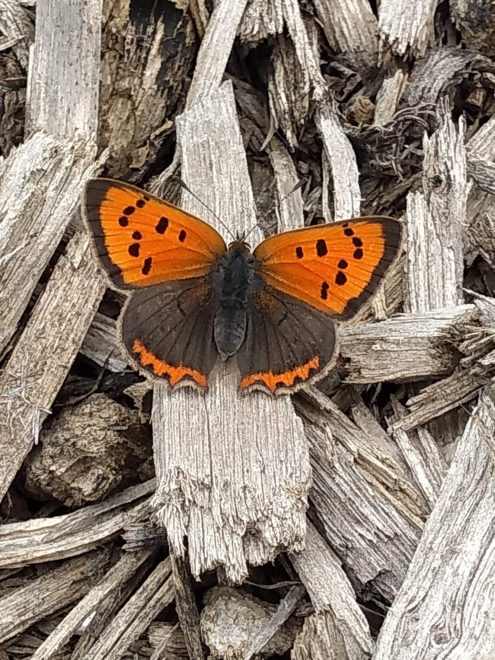 The Small Copper is a fast-flying butterfly that, once settled, is unmistakable with its bright copper-coloured forewings. A favourite of Assistant Ranger Sophie Brown, she explains: “I like them solely for the superficial fact that when you first see them, freshly emerged they are so vibrant with such a dainty flight. The one in this picture is a female stuffed full of eggs as you can see by her rotund abdomen.”
The Small Copper is a fast-flying butterfly that, once settled, is unmistakable with its bright copper-coloured forewings. A favourite of Assistant Ranger Sophie Brown, she explains: “I like them solely for the superficial fact that when you first see them, freshly emerged they are so vibrant with such a dainty flight. The one in this picture is a female stuffed full of eggs as you can see by her rotund abdomen.”
Small Blue
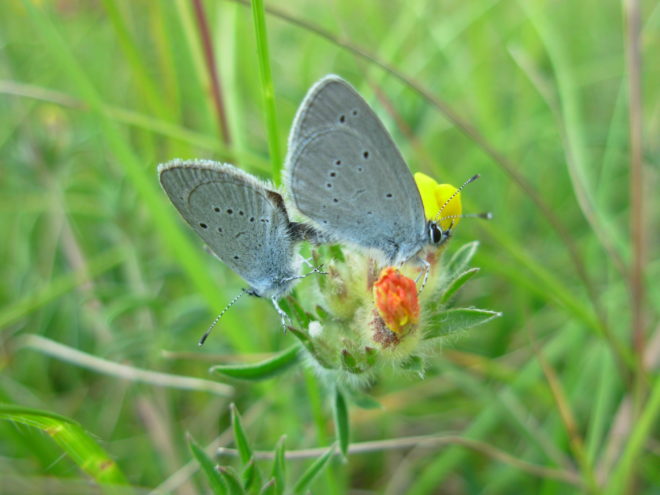 This dainty butterfly is easily overlooked, partly because of its size and dusky colouring, but partly because it is often confined to small patches of sheltered grassland where its sole food plant, Kidney Vetch, is found. This majestic insect is a favourite of Assistant Ranger Michaela Pape, who has been enjoying taking photographs of butterflies for over 10 years.
This dainty butterfly is easily overlooked, partly because of its size and dusky colouring, but partly because it is often confined to small patches of sheltered grassland where its sole food plant, Kidney Vetch, is found. This majestic insect is a favourite of Assistant Ranger Michaela Pape, who has been enjoying taking photographs of butterflies for over 10 years.
Dark Green Fritillary
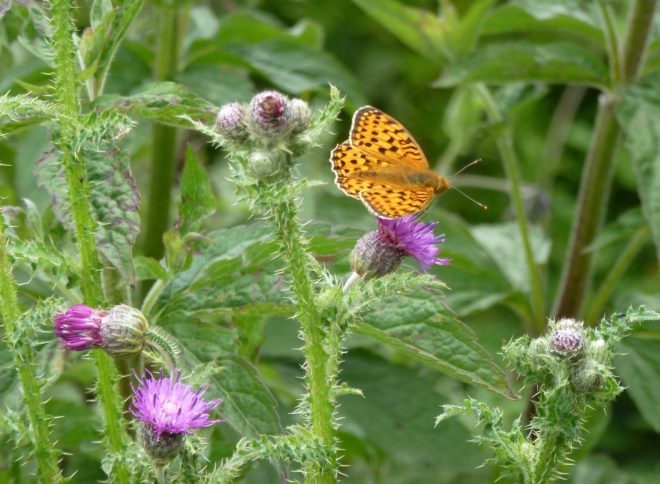 The dark green fritillary is actually an orange butterfly with black spots. It gets its name from the dark green hue to the undersides of its hindwings. A strong flier, it can be seen on open, grassy habitats. A favourite of Ranger Jan Knowlson, she says: “I love the Dark Green Fritillary, mainly because they colonised a site I worked on immediately after we had worked hard improving the area. It brought me great joy!”
The dark green fritillary is actually an orange butterfly with black spots. It gets its name from the dark green hue to the undersides of its hindwings. A strong flier, it can be seen on open, grassy habitats. A favourite of Ranger Jan Knowlson, she says: “I love the Dark Green Fritillary, mainly because they colonised a site I worked on immediately after we had worked hard improving the area. It brought me great joy!”
Small White
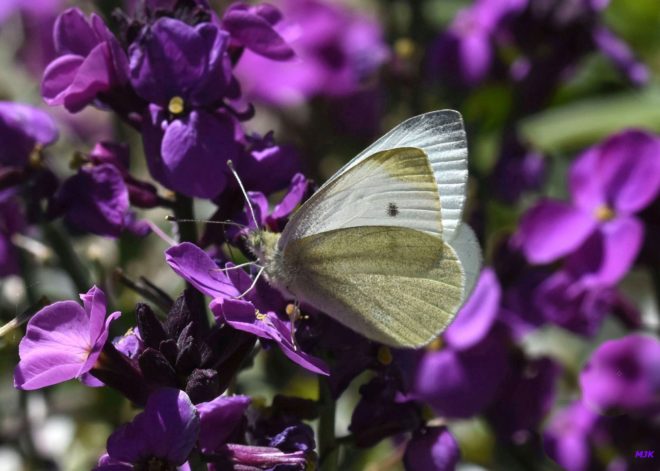
Small white butterfly, also known as cabbage white butterfly, are often seen as a rather dull member of a family of insects known for their fantastic patterns and colours. However, this is a misconception held only due to the limitations of the human eye. Ranger Chris Lickley explains: “When seen under ultraviolet light female butterfly reflect a lavender hue whilst males show as a brilliant royal purple. The strength of these colours directly relates to the health of the butterfly, the healthiest growing from those caterpillars who ate the most cabbage and kale while they were growing. Eat your veg kids!”
Brimstone
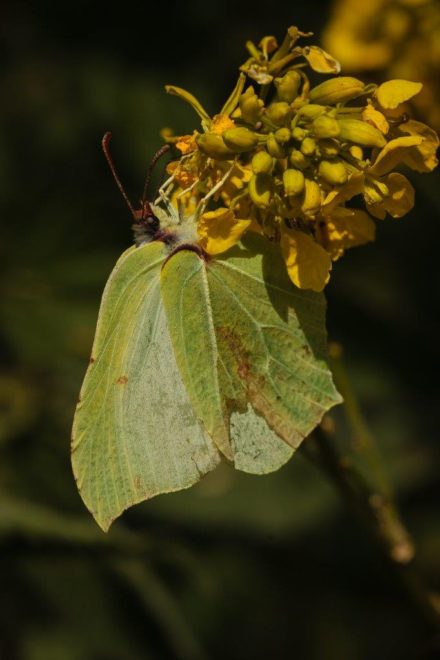 The Brimstone is a fairly large, pale yellow butterfly, with distinctive, leaf-shaped wings. This one is loved by Western Downs Lead Ranger Elaina Whittaker-Slark. She says: “The brimstone is my favourite butterfly as its one of the first ones we see in the early spring to tell us spring is definitely on the way. It’s also a tough little butterfly living for a whole year. It’s commonly thought that the brimstone gave butterflies their name, due to the buttery colour of the males’ wings, as well as when traditional butter makers were first outside churning butter it would be the butterfly they saw.”
The Brimstone is a fairly large, pale yellow butterfly, with distinctive, leaf-shaped wings. This one is loved by Western Downs Lead Ranger Elaina Whittaker-Slark. She says: “The brimstone is my favourite butterfly as its one of the first ones we see in the early spring to tell us spring is definitely on the way. It’s also a tough little butterfly living for a whole year. It’s commonly thought that the brimstone gave butterflies their name, due to the buttery colour of the males’ wings, as well as when traditional butter makers were first outside churning butter it would be the butterfly they saw.”
Grizzled Skipper
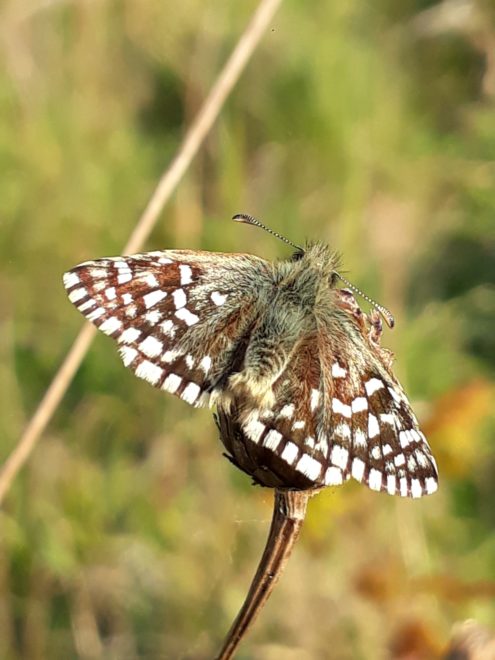 This small butterfly, typical of southern chalk downland, begins to emerge in late April to early May, having spent winter as pupae within cocoons of leaves and silk amongst low vegetation. Once on the wing it’s easy to miss, darting quickly between perches and nectar sources – typically Common Bird’s-foot-trefoil and Bugle. If you are lucky enough to get a glimpse of one perched on a twig, it can then be easily identified by the checkerboard pattern on its wings. Adored by Ranger Charles Winchester, he says: “It’s an often overlooked species, due to it being rare and quite low-key in appearance, but I think it’s super smart looking and just a really cool little butterfly.”
This small butterfly, typical of southern chalk downland, begins to emerge in late April to early May, having spent winter as pupae within cocoons of leaves and silk amongst low vegetation. Once on the wing it’s easy to miss, darting quickly between perches and nectar sources – typically Common Bird’s-foot-trefoil and Bugle. If you are lucky enough to get a glimpse of one perched on a twig, it can then be easily identified by the checkerboard pattern on its wings. Adored by Ranger Charles Winchester, he says: “It’s an often overlooked species, due to it being rare and quite low-key in appearance, but I think it’s super smart looking and just a really cool little butterfly.”
Orange tip butterfly
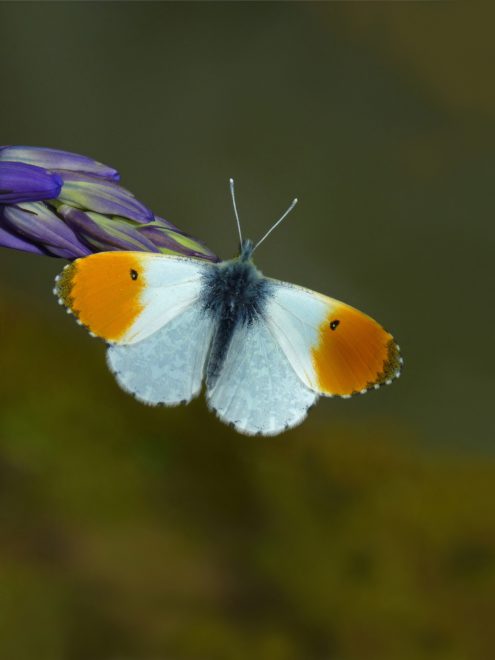 The orange-tip is a true sign of spring, being one of the first species to emerge that has not overwintered as an adult. Ranger Chloe Goddard always loves seeing it and explains: “It’s a fairly common butterfly which can be seen across our countryside and often in gardens. I love the bright orange tips on the male’s wings which stand out brilliantly from the perfect white of the rest of the wing. If the butterfly sits still long enough you’ll see that both the male and female have a beautiful and intricate mottled green underwing which is actually made up of a combination of yellow and black wing scales.”
The orange-tip is a true sign of spring, being one of the first species to emerge that has not overwintered as an adult. Ranger Chloe Goddard always loves seeing it and explains: “It’s a fairly common butterfly which can be seen across our countryside and often in gardens. I love the bright orange tips on the male’s wings which stand out brilliantly from the perfect white of the rest of the wing. If the butterfly sits still long enough you’ll see that both the male and female have a beautiful and intricate mottled green underwing which is actually made up of a combination of yellow and black wing scales.”
Marbled White butterfly
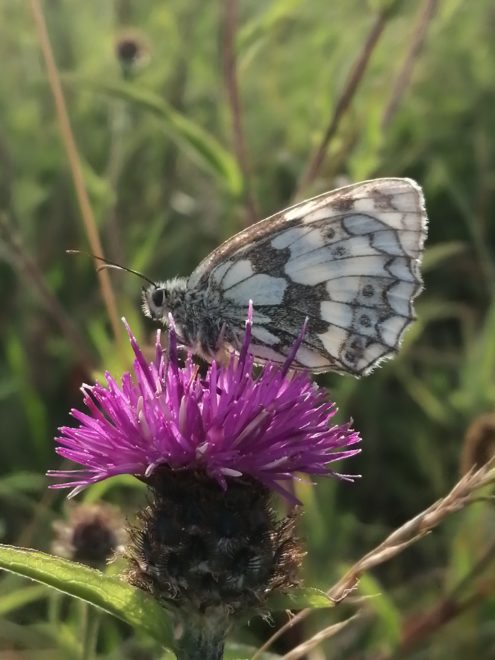 The Marbled White is a distinctive and attractive black and white butterfly, unlikely to be mistaken for any other species. Apprentice Ranger Gemma North says: “How beautiful they are! Although if I’m being completely honest I think all butterflies are beautiful!”
The Marbled White is a distinctive and attractive black and white butterfly, unlikely to be mistaken for any other species. Apprentice Ranger Gemma North says: “How beautiful they are! Although if I’m being completely honest I think all butterflies are beautiful!”
Adonis Blue
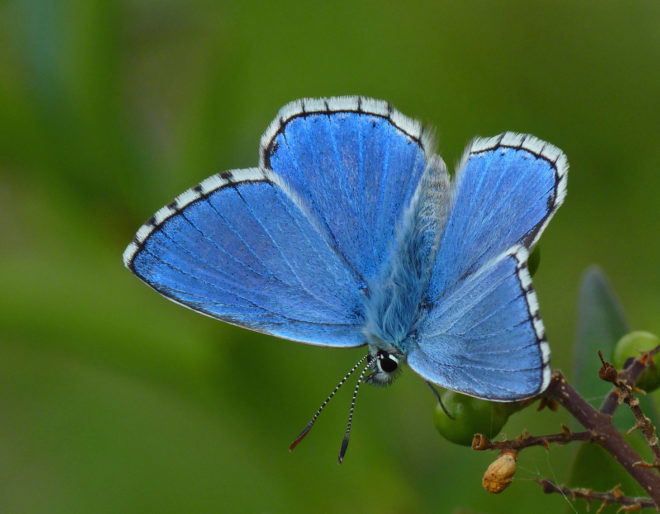 No top 10 of butterflies on the South Downs would be complete without a mention for this iconic species – a true entomological stunner! A firm favourite with all the rangers, the Adonis loves chalk downland, where it can be found in warm, sheltered spots. The male Adonis Blue has brilliantly-coloured blue wings that gives this butterfly its name, and can be found flying low over vegetation, seeking out the less-conspicuous females that are a rich chocolate brown in colour.
No top 10 of butterflies on the South Downs would be complete without a mention for this iconic species – a true entomological stunner! A firm favourite with all the rangers, the Adonis loves chalk downland, where it can be found in warm, sheltered spots. The male Adonis Blue has brilliantly-coloured blue wings that gives this butterfly its name, and can be found flying low over vegetation, seeking out the less-conspicuous females that are a rich chocolate brown in colour.
Thanks to Butterfly Conservation and the Wildlife Trusts for additional information on the butterfly species. Thanks also to Neil Hulme for the additional photography.
Five ways you can help butterflies flourish
Butterflies play a pivotal role in nature. Pollinators such as butterflies and bees are responsible for at least a third of human food production, and without them, the fruits and vegetables we eat would be much harder to grow.
Gardens can act as important stepping stones between nature reserves and other natural habitats by offering abundant supplies of nectar and food plants.
Here are five ways to help the butterflies flourish with some green-fingered know-how:
- Don’t use insecticides and pesticides – they kill butterflies and many pollinating insects as well as ladybirds, ground beetles and spiders.
- Butterflies like warmth so choose sunny, sheltered spots when planting nectar plants.
- Choose different plants to attract a wider variety of species. Place the same types of plant together in blocks.
- Prolong flowering by deadheading flowers, mulching with organic compost, and watering well to keep the plants healthy.
- Try to provide flowers right through the butterfly season. Spring flowers are vital for butterflies coming out of hibernation and autumn flowers help butterflies build up their reserves for winter.
For more information visit https://butterfly-conservation.org/
